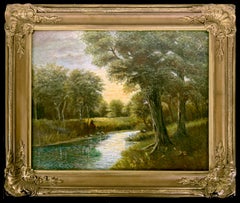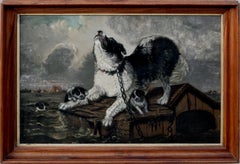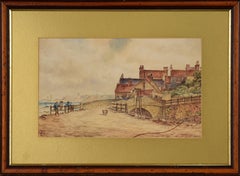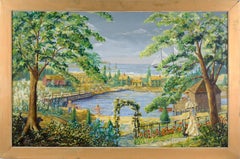Want more images or videos?
Request additional images or videos from the seller
1 of 11
Three Sisters in the Cascade Range, Oregon Lake with Birds Migrating1890-1900
1890-1900
Price:$2,200
$2,550List Price
About the Item
- Attributed to:John Englehart (1867 - 1915)
- Creation Year:1890-1900
- Dimensions:Height: 36 in (91.44 cm)Width: 55 in (139.7 cm)Depth: 3 in (7.62 cm)
- Medium:
- Movement & Style:
- Period:
- Condition:Very good condition. 4 slight/splits tears to the linen professionally repaired. Professionally cleaned and UV protective varnish applied. Period frame in good but rough finish, included as-is.
- Gallery Location:Soquel, CA
- Reference Number:Seller: N8361*1stDibs: LU54213374842
About the Seller
5.0
Platinum Seller
Premium sellers with a 4.7+ rating and 24-hour response times
Established in 1986
1stDibs seller since 2014
3,053 sales on 1stDibs
Authenticity Guarantee
In the unlikely event there’s an issue with an item’s authenticity, contact us within 1 year for a full refund. DetailsMoney-Back Guarantee
If your item is not as described, is damaged in transit, or does not arrive, contact us within 7 days for a full refund. Details24-Hour Cancellation
You have a 24-hour grace period in which to reconsider your purchase, with no questions asked.Vetted Professional Sellers
Our world-class sellers must adhere to strict standards for service and quality, maintaining the integrity of our listings.Price-Match Guarantee
If you find that a seller listed the same item for a lower price elsewhere, we’ll match it.Trusted Global Delivery
Our best-in-class carrier network provides specialized shipping options worldwide, including custom delivery.You May Also Like
Tonalist Painting Sunset Figures Wheat Barbizon Framed 19th Century Oil Painting
Located in Buffalo, NY
An antique oil painting in its original ornate gold leaf frame.
This tonalist painting depicts figures against a dramatic sunset.
The work is signed illegibly lower left. It ap...
Category
1860s Tonalist Figurative Paintings
Materials
Canvas, Oil
$2,280 Sale Price
20% Off
H 23.5 in W 29.5 in
"Autumn, New England" Charles Warren Eaton, Tonalist Gloaming Sunset in Woods
By Charles Warren Eaton
Located in New York, NY
Charles Warren Eaton
Autumn, New England
Signed lower right
Oil on canvas
30 x 36 inches
Provenance
Private Collection, Connecticut
A contemporary critic wrote that the paintings o...
Category
Early 1900s Tonalist Figurative Paintings
Materials
Canvas, Oil
"Farmland Meadows" George Henry Smillie, Hudson River School, Sunset Landscape
By George Henry Smillie
Located in New York, NY
George Henry Smillie
Farmland Meadows, 1865
Signed and dated lower left
Oil on canvas
10 1/2 x 18 inches
Provenance
Private Collection, Langley, Washington
The career of George Sm...
Category
1860s Tonalist Figurative Paintings
Materials
Canvas, Oil
French school Landscape river scene Signed
Located in Zofingen, AG
➡️ Beautiful study Landscape⬅️
Title: Sur les bords du Loing (Seine et Marne France) Jean Baptiste Camille Corot
Medium: Oil on canvas
Period: Likely mid-19th century
Framing: A wid...
Category
1850s Tonalist Figurative Paintings
Materials
Gesso, Canvas, Oil, Stretcher Bars
$131,762 Sale Price
26% Off
H 14.18 in W 21.46 in D 1.58 in
French school The River Oil painting Signed
Located in Zofingen, AG
➡️The River from Rousseau⬅️
"Il est tombé par terre, C'est la faute à Voltaire, Le nez dans le ruisseau, C'est la faute à Rousseau" - He fell to the ground, It's Voltaire's fault, H...
Category
1890s Tonalist Figurative Paintings
Materials
Gesso, Canvas, Oil, Stretcher Bars
$598 Sale Price
79% Off
H 12.41 in W 18.71 in D 1.19 in
French School Impressionist The old watermill oil painting
Located in Zofingen, AG
➡️Vivid Landscape⬅️
⏩It is signed R Hesse, probably René Jean Hesse (1910-2000) ⏪
René Hesse was a French painter whose art captured the essence of rural Lorraine with remarkable s...
Category
Early 1900s Tonalist Figurative Paintings
Materials
Gesso, Canvas, Oil, Stretcher Bars
$898 Sale Price
79% Off
H 19.69 in W 29.53 in D 1.97 in
French school Landscape riverside Signed
Located in Zofingen, AG
➡️Vivid Landscape⬅️
➡️Impressionist Scene⬅️
⏩It is signed Jeanneau.⏪
Possibly Fernand Jeanneau,
⭐Medium:⭐ Oil on canvas
⭐Technique: ⭐Impasto painting with expressive brushwork. H...
Category
1850s Tonalist Figurative Paintings
Materials
Gesso, Canvas, Oil, Stretcher Bars
$383 Sale Price
77% Off
H 11.62 in W 16.15 in D 0.79 in
"Summer Evening in the Swedish Archipelago", original oil on canvas, Tonalist
Located in Naples, Florida
This is an original unique oil painting by the artist. Sigfrid Andreas "Sigge" Jernmark (July 9, 1887 – July 12, 1982) was a Swedish painter, cartoonist and decorator. Jernmark recei...
Category
20th Century Tonalist Landscape Paintings
Materials
Canvas, Oil
$7,500
H 31.5 in W 38 in D 4 in
French School - Landscape New York WTC Sunset - NYC Building DLC (Large)
Located in Zofingen, AG
New York One World Trade Center urban view
⭐Technique⭐: oil, acrylic, and ink on old book pages on wooden frame 55x55cm ■■ 21,6x21,6 inch
➡️》R E A D Y -- T O -- H A N G《⬅️
🟢 → O...
Category
Early 1900s Tonalist Figurative Paintings
Materials
Oil, Acrylic, Ink
$898 Sale Price
55% Off
H 21.66 in W 21.66 in D 1.19 in
French School Impressionist Landscape Le Lac Rose th century MAK
Located in Zofingen, AG
Landscape Le lac Rose - Pink Lake
Technique: oil, acrylic, ink on wood frame 40x40cm / 15,7x15,7inch
⭐Sustainability⭐: Wooden frame is made by the artist by ...
Category
Early 1900s Tonalist Figurative Paintings
Materials
Ink, Oil, Acrylic
$455 Sale Price
68% Off
H 15.75 in W 15.75 in D 1.38 in
More From This Seller
View AllArtist Sitting by the stream 19th Century Tonalist Landscape
Located in Soquel, CA
An Artist sitting by the stream, Mid-19th Century Tonalist Landscape
Gorgeous landscape painting by unknown artist, 1900+-. This impressive Tonalist landscape, untitled, depicts a s...
Category
1890s Tonalist Figurative Paintings
Materials
Oil, Illustration Board, Linen
"Inundation" after Carl Fredrik Kiörboe - "ÖVERSVÄMNING" Dogs During a Flood
By Carl Fredrik Kiorboe
Located in Soquel, CA
"Inundation" after Carl Fredrik Kiörrboe - Dogs During a Flood
Oil on linen painting of a family of dogs in a flood by an unknown artist, unsigned, after an engraving of the painting...
Category
Early 1900s Tonalist Figurative Paintings
Materials
Oil, Acrylic, Illustration Board
English Country Landscape - Original Painting on Paper by Oliver Louis Tweddle
Located in Soquel, CA
English Country Landscape - Watercolor on Paper
Watercolor painting depicting an American country landscape by Oliver Louis Tweddle (English, B-1860). Four fishermen stand upon a br...
Category
1890s Tonalist Landscape Paintings
Materials
Watercolor, Board, Laid Paper
"Harborside Bathers" Large Scale Landscape with Figures and Boats in Acrylic
Located in Soquel, CA
"Harborside Bathers" Large Scale Landscape with Figures and Boats in Acrylic
Idyllic harbor landscape with bathers and boats by Richard M. Bacon (American, 20th Century). Richard is...
Category
1990s Tonalist Landscape Paintings
Materials
Masonite, Acrylic
Olive Harvest in Southern Italy on Cold Coastal Morning Italian Riviera
Located in Soquel, CA
Olive Harvest in Southern Italy on Cold Coastal Morning Italian Riviera
Olive Harvesters are bundled up against the cold and dust on a harvest morning, somewhere on the southern It...
Category
1980s Symbolist Figurative Paintings
Materials
Linen, Oil, Stretcher Bars
19th Century Original Oil Malaysian Fishermen and Schooner
Located in Soquel, CA
19th Century Impressionist Original Oil Painting of Malaysian Fishermen and Schooner by Alberto Bonghi
The painting is a depiction of a scene in Malaysia with a Schooner in backgro...
Category
1890s Impressionist Figurative Paintings
Materials
Linen, Oil, Stretcher Bars



